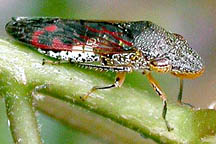
|
Whatever
Happened To... |
Bugs proving to be
less of a problem
Question: What ever happened to the invasion of glassy-winged sharpshooter insects, which the state Department of Agriculture found in Leeward Oahu in May and feared could harm Hawaii citrus, coffee, nut tree and ornamental plant crops?

|
"It's always bad news when you get a new creature in Hawaii" that has been an agricultural pest elsewhere, Nakahara said.
In California the sharpshooters (Homalodisca coagulata) have caused major problems with grape crops by spreading the bacterium Zylella fastidiosa, which causes the lethal Pierce's disease. Scientists feared that related bacterial diseases spread by the bugs could attack Hawaii crops, Nakahara said.
Testing has shown that the sharpshooters that came here apparently did not bring the bacterial disease with them, Nakahara said.
Meanwhile, Ag Department researchers discovered that "something is attacking the sharpshooter, which will slow down its distribution and limit its abundance," Nakahara said. A tiny predatory wasp lays eggs inside the eggs of sharpshooters, so they never hatch out, he said.
So, despite the bug's unwanted arrival, "The good news is it doesn't look like it's going to cause any problems," Nakahara said.
The sharpshooters are about a half-inch long and are mostly brown, with ivory and black markings on the abdomen and large smoky-brown wings with red markings. Immature bugs are wingless and gray.
When the bugs proliferate, they can cause a phenomenon called "sharpshooter rain," which is thousands of bugs on a tree area excreting liquid in annoying volumes, Nakahara said.
"In the beginning, when we first learned about the pest, we were concerned about it," Nakahara said. "Now we're more relieved."
[News] [Business] [Features] [Sports] [Editorial] [Do It Electric!]
[Classified Ads] [Search] [Subscribe] [Info] [Letter to Editor]
[Feedback]
